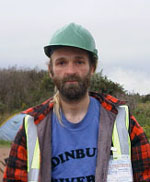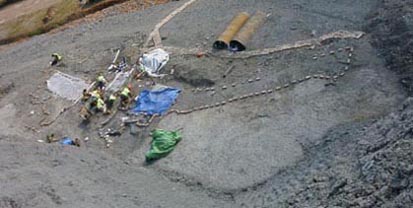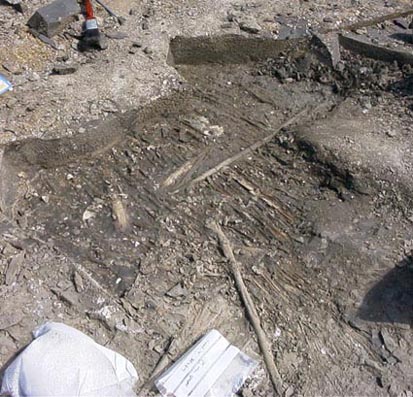- CBRP Ltd
- 20 Fernwood Drive
- Radcliffe on Trent
- Nottingham
- NG12 1AA
Lessons from a Dead Fish
You don't just learn lessons about business by going to seminars, or attending lectures, or enrolling on courses at business schools. Sometimes we can learn a lot from quite unexpected sources - even dead fish!
expect the unexpected
When Matt pulled something unusual out of the face of a brick pit, he didn't have any idea of what he had started. Being a responsible student (not necessarily a contradiction in terms!) he took it back to Portsmouth University where he is studying geology. Dave Martill, his supervisor, is an expert on the animals that lived in the Peterborough area 150 million years ago. Dave recognised it as being a bone from a fish, and not just any fish. It came from the skeleton of the biggest fish that ever lived, a little-known animal that scientists call Leedsichthys.

Jeff, 6 weeks into the dig, and showing the strain
By a curious coincidence Jeff Liston, another of Dave's students had just started a PhD on this very creature. They went back to the pit, and found that the bones poked out of the face of the clay over a distance of 8 meters.
take a gamble
The bones were near the bottom of a 60 foot high pit wall, and to find out if there were any more meant that a huge volume of clay had to be removed. The cost would be high - it meant hiring an excavator and driver for a week, and that doesn't come cheap! However, the find was potentially very important.
What Jeff and Dave didn't know was if the bones there were finding were the last few left after the rest of the fish had been made into bricks, or were the first few to be exposed from a complete skeleton. They decided that the gamble had to be made, funds were raised, and 10,000 tons of clay were removed.
the worst case scenario...
You don't commit resources to a large excavation without careful planning, even though it is by it's very nature an unknown quantity. You look at 'best case' and 'worst case' scenarios. In this the best case scenario was also a worst case scenario. If no more bones were found, then the excavation would be finished in a week, everyone could go home, and thousands of pounds would have been wasted.
The worst case scenario calculated like this: The best specimen of this fish consists of a collection of about 500 bones. If this is an even better specimen, there may be as many as 1000 bones to be collected, and this will take about 4 weeks.
and what happened next..
So a team of students and volunteers was organised, and the hard and delicate work of uncovering the skeleton was started. Six weeks later, nearly 3000 bones had been uncovered over an area measuring 6 by 23 meters, and there were large areas of the site still to be explored. The worst case scenario (which in other ways is a best case scenario, of course!) had been vastly exceeded. It was left to a hard core of volunteers to carry on digging for as long as the weather allowed. In the end the site was carefully covered up, and the process of raising funds for an extended excavation in 2003 started.

The site viewed from above
changing circumstances
When the dig started, it all seemed very straightforward. Skeletons of extinct animals have been excavated from the Peterborough area for over 200 years, and the methods of doing so are tried and tested. The trouble is, they don't work so well on giant fish, as the team quickly discovered. Most of the other finds are of reptiles - plesiosaurs and ichthyosaurs - whose bones are big and solid.
Even the biggest skeletons found intact are no more than about 4 meters long, and are often partly enclosed on blocks of hard limestone. The best technique is to wrap the specimen as a series of large blocks in the same way your local hospital will plaster a broken leg. That way all the bones are kept together, and they can be taken back to the laboratory in large blocks where the bones can be cleaned up and recorded in controlled conditions.
When it came to the fish - which by this time had gained the nickname 'Ariston' - these methods were not very suitable. In spite of it's size, most of the bones are thin and fragile. Because of the way the giant carcase decayed on the sea floor the bones are in tangled layers. Bones could not be left exposed on the surface for long, as they would quickly dry out and blow away. Because of this, a lot of work which would normally be done in the laboratory had to be done on site, all of which extended the time taken by the excavation.

A huge fin waiting to be lifted
Be prepared
The story is not finished. The excavation was opened up for two weeks again in August of this year, and there are plans to clear back more of the cliff and go back again next year. Channel 4 has made a programme about the find which will be screened next Monday (8th September) as part of the 'Big Dig' series.
My involvement? Some people like to go to the West Indies or the Seychelles for their holidays. A brick pit is far more fun! It's hard work, in clinging mud when it's raining or with fine dust blowing into your nostrils when the sun is out, but the fascination of uncovering the bones of a huge animal that last saw the light of day 150 million years ago far outweighs any discomfort.
...and Ariston
?
If you haven't figured it out yet, think back to the advertisement: "Ariston, goes on, and on and on and on and on . . ."